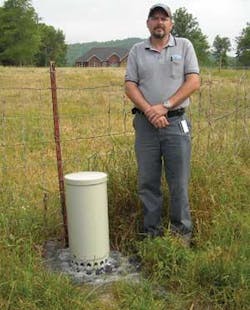Automatic Flushing Helps Improve Water Quality
Consolidated Utility District (CUD), located in Murfreesboro, TN, is a large water system that encompasses over 1,300 miles of both urban and rural water lines throughout Rutherford County.
In early 2006, CUD received a notice of violation from the state of Tennessee for exceeding disinfection byproduct limits. At that time, its flushing program consisted of two employees that would address problem areas as needed. The process was time consuming and ineffective.
When CUD began receiving customer inquiries because of the required public notice regarding the violation, Assistant General Manager Bill Dunnill ordered three Kupferle #9700 portable automatic flushing devices to assist in maintaining water quality.
Focusing on the most troublesome areas first, CUD began to test the effectiveness of the flushing devices, which attach directly to any existing fire hydrant.
“CUD saw immediate water quality improvement and subsequent testing proved that they had a positive impact on disinfection byproducts,” Dunnill said.
CUD was able to improve its flushing program with the automatic flushing devices. Staff increased flushing frequency and reduced total flushing volumes and water usage. Chlorine residuals were staying at desired levels and customer complaints went down.
“We actually had a few customers request the automatic flushers,” said Mark Lee with Water Quality.
Over a period of two years the Utility District has acquired over 30 automatic flushing units that consist of a mix of both portable and permanent flushers.
Permanent Installations
CUD currently ties its permanent automatic flushers, the Kupferle #9400, with AMR meters. This allows staff to accurately account for flushing volumes to improve water loss control. It also provides flow data that aids CUD in setting the correct duration for flushing.
Most of the 9400s are set to flush 15 to 30 minutes several times per week. Flushing is done in the early morning hours during low demand to minimize the effect on the customer water pressure.
The district also uses portable automatic flushers when isolated water quality situations arise. Once the area has been flushed and the water quality issue resolved, the unit is moved to another location or stored until needed again.
Water Quality
The district has experienced significant reductions in TTHMs and HAAs in the areas that were previously some of the most troublesome. Regulations require water systems to keep their annual average TTHMs under .08 and annual average HAAs less than .06.
CUD has found more time to concentrate on other water quality issues since the automatics have been handling a significant portion of flushing.
“The benefits far out-weigh the cost. We couldn’t have hired enough people to do the same job these units have done,” Dunnill said. WW
Kupferle® is an exhibitor at the WEFTEC 09. event and can be found at Booth No. 2793

